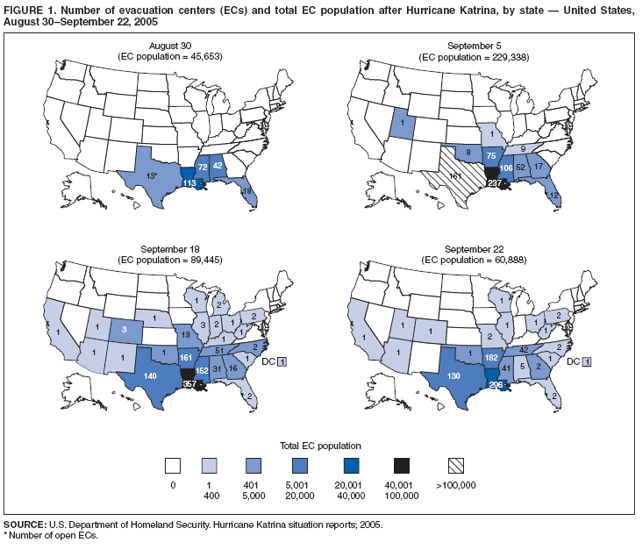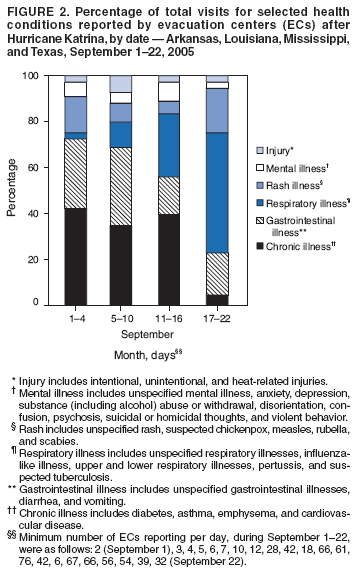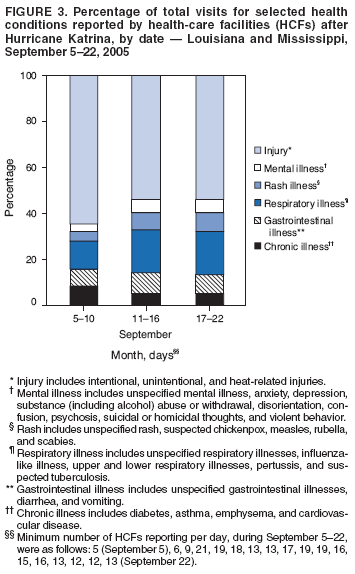 |
|
|
|
|
|
|
| ||||||||||
|
|
|
|
|
|
|
||||
| ||||||||||
|
|
|
|
|
Persons using assistive technology might not be able to fully access information in this file. For assistance, please send e-mail to: mmwrq@cdc.gov. Type 508 Accommodation and the title of the report in the subject line of e-mail. Morbidity Surveillance After Hurricane Katrina --- Arkansas, Louisiana, Mississippi, and Texas, September 2005Hurricane Katrina made landfall on the U.S. Gulf Coast on August 29, 2005. Thousands of Gulf Coast residents evacuated and dispersed across the country, moving into hotels, private homes, and evacuation centers (ECs) in 30 states and the District of Columbia (DC). One goal of public health responders was to identify and prevent hurricane-related morbidity and mortality among affected populations, especially among those with limited access to health care and those who were living in crowded conditions. This report summarizes the challenges of conducting national surveillance after Hurricane Katrina, focusing on the role of CDC in coordinating surveillance and consolidating and interpreting morbidity data from jurisdictions that used diverse surveillance approaches. Aggregate morbidity data that were reported through Arkansas, Louisiana, Mississippi, and Texas to CDC during September 1--22, 2005 (before the Gulf Coast landfall of Hurricane Rita on September 24) are presented from ECs and health-care facilities (HCFs) that served affected populations in these states. Chronic diseases and injuries were the most common conditions reported by ECs and HCFs, respectively. To better prepare for future large-scale disasters with widespread impact, public health agencies and other partners are actively working to establish standardized guidelines and tools for morbidity surveillance. These guidelines will facilitate the interpretation and exchange of health information among multiple jurisdictions and public and private agencies during a disaster response to identify outbreaks and monitor health concerns. After landfall of Hurricane Katrina, in collaboration with state and local health departments, CDC developed and disseminated guidelines and a form for reporting daily aggregate morbidity surveillance data for persons evaluated in ECs and HCFs (e.g., hospitals, emergency departments, clinics, and disaster medical assistance team [DMAT] sites*) (2). This morbidity surveillance form included categories for conditions such as infectious diseases, mental health conditions, injuries, and chronic diseases. In addition, a separate medical intake form was distributed to record individual-level data (2). The form included some of the same conditions and categories as the aggregate form but included additional (primarily noninfectious) conditions. The surveillance approach chosen by state and local health departments varied and depended on local conditions, information needs, number of facilities providing health-care services, feasibility of implementation, and overall surveillance capacity (e.g., staffing and communications) (3--5). Health departments investigated possible disease outbreaks and identified resources for managing various health conditions. Although CDC received aggregate surveillance data from 12 states, this report presents data from the four states that reported regularly on the largest numbers of affected persons (Arkansas, Louisiana, Mississippi, and Texas). All four states reported morbidity surveillance data from ECs; Louisiana and Mississippi also collected and reported surveillance data from HCFs to determine the extent of injuries and acute conditions resulting from the hurricane and to monitor HCF capacity and needs. In Arkansas and Texas, because most evacuees were in ECs, routine HCF surveillance continued among health-care providers and laboratories as it had before the hurricane, with added encouragement from health departments to report adverse health events among evacuees. States reported morbidity data, which differed by number and specificity of conditions under surveillance; for example, some states reported three distinct types of gastrointestinal (GI) illness, whereas others aggregated all GI-related symptoms and reported them collectively as GI illness. CDC summarized morbidity data by state on a daily basis. For this report, state-specific data were combined to facilitate multistate analyses. Totals for the six most commonly reported categories (i.e., chronic illness, GI illness, respiratory illness, rash, mental illness, and injury) were calculated as the sum of specific (e.g., suspected tuberculosis) and nonspecific (e.g., lower respiratory tract illness) conditions. Data for conditions that were rarely or inconsistently reported are not presented. A visit was defined as care provided for one person for one condition. Persons could have received care for more than one condition on a given day, received care for the same condition on multiple days, or both. Morbidity rates could not be calculated because not all HCFs reported total numbers of patient visits, and although state-level EC population figures were available, not all reporting ECs provided facility population data. The number of ECs open in a state, the total EC population in a state, and the number of states hosting ECs fluctuated daily (Figure 1). During September 1--22, the number of ECs and HCFs in Arkansas, Louisiana, Mississippi, and Texas reporting daily morbidity data to CDC also fluctuated, ranging from two to 76 ECs and five to 21 HCFs (Figures 2 and 3). Louisiana and Mississippi reported HCF data almost daily beginning September 5. During September 1--22, chronic illness (e.g., diabetes, asthma, emphysema, and cardiovascular disease) was the most commonly reported category in ECs, peaking at 651 visits on September 9 (in all four states combined) and accounting for 33% (4,786) of the 14,531 total visits included in these analyses. GI illness, the second most commonly reported category, accounted for 27% (3,892) of total visits and peaked in ECs during September 5--10. Visits for respiratory illness increased during September 1--22, accounting for 20% (2,896) of total visits and 52% (1,003) of visits during September 17--22. The percentage of visits for rash illnesses accounted for 16% (320) of visits during September 1--4, decreased somewhat, and then increased again to 20% (376) of visits during September 17--22. Visits for injury and mental illness accounted for less than 6% each of the total visits during September 1--22. In HCFs, during September 5--22, injury was the most commonly reported category, with approximately 135 visits reported daily, peaking at 532 on September 8, and accounting for 58% (5,716) of 9,772 total HCF visits for the six categories. Respiratory illness was the second most commonly reported condition, accounting for 16% (1,550) of total HCF visits. During September 5--22, GI, rash, and chronic and mental illnesses each accounted for less than 10% of the total HCF visits. Reported by: F Averhoff, MD, S Young, MPH, J Mott, PhD, A Fleischauer, PhD, CDC Louisiana Epidemiology and Surveillance Field Team; J Brady, MD, US Public Health Svc Louisiana Evacuee Center Surveillance Team; S Straif-Bourgeois, PhD, Louisiana Office of Public Health. A Valadez, MD, D Lurie, MBA, Austin/Travis County Dept of Health and Human Svcs; H Palacio, MD, Harris County Public Health and Environmental Svcs; D Buhner, MD, Dallas County Health and Human Svcs; D Persse, MD, City of Houston Health and Human Svcs; F Guerra, MD, San Antonio Metropolitan Health District; J Morgan, MD, J Zoretic, MD, Texas Dept of Health Svcs. R Moolenaar, MD, CDC Mississippi Injury and Illness Surveillance Field Team; KM McNeill, MD, P Byers, MD, TS Kittle, MPH, Mississippi Dept of Health. G Chavez, MD, CDC Arkansas Field Team; M Phillips, PhD, Arkansas Dept of Health and Human Svcs. D Koo, MD, S Groseclose, DVM, P Hicks, MPH, NF Jones, MBChB, A Kenneson, PhD, Director's Emergency Operations Center; P Vranken, DPH, E Sergienko, MD, RH Bitsko, PhD, SA Lorick, DO, EIS officers, CDC. Editorial Note:After Hurricane Katrina, public health concerns included infectious disease outbreaks, injuries, mental health disorders, and exacerbation of preexisting chronic conditions resulting from population displacement, crowded living conditions in ECs, and disruption of public health services and health-care infrastructure (6). Routine surveillance systems were disrupted in some areas, and coordinated surveillance systems dedicated to monitoring morbidity among persons affected by widespread disasters had not yet been developed in the United States. CDC and the states conducted specialized surveillance activities to complement existing surveillance systems. In addition, CDC collaborated with state and local jurisdictions to facilitate the use of standardized morbidity surveillance tools. Some jurisdictions collected individual-level data to support the provision of clinical care and focus local public health response; aggregated surveillance data reported to CDC were used to monitor morbidity trends and help identify suspected disease outbreaks. Morbidity data from Arkansas, Louisiana, Mississippi, and Texas indicated that chronic conditions and injuries were the most frequently reported conditions among affected populations in ECs and HCFs, respectively. This pattern is similar to that identified after floods and other hurricanes (7--9). Variations in the catchment populations, triage protocols, surveillance approaches, and educational background and training of staff members who were collecting data probably contributed to the differences in health conditions identified at ECs and HCFs. ECs likely served persons with less severe conditions, whereas HCFs likely served persons with acute and more severe conditions. Combined with reports from other federal agencies, the state-reported morbidity data helped CDC and the states target deployment of response personnel, prevent and control outbreaks (such as the norovirus outbreak in Texas [10]), and reassure the public that no major epidemics were occurring. State and local jurisdictions with ECs and HCFs had to balance resources between surveillance activities and responses to the immediate and evolving needs of affected populations, such as providing primary health-care services and medication refills. Local health departments and their partners also had to address the immediate medical needs of persons with special needs, mental disorders, and numerous comorbid conditions. A major challenge at the federal level was to integrate data derived from surveillance systems that varied by location of surveillance, enumeration of populations, forms used for data collection, and the specific conditions assessed. During the response, federal surveillance was aided by communication with field surveillance staff members and information provided in daily situation reports from states and other agencies, including the American Red Cross and U.S. Department of Homeland Security. The findings in this report are subject to at least four limitations. First, morbidity rates could not be calculated because population data for ECs and HCFs were incomplete. Second, variability in the number of facilities and total population under daily surveillance limited interpretation of temporal trends. Third, the specificity of reported conditions varied because different reporting forms were used; thus, some data could not be aggregated. Finally, these findings do not provide a comprehensive description of the impact of the hurricane and evacuation and dispersal of the affected population because the morbidity surveillance varied considerably (i.e., was not always complete and was not always representative). The primary goal for public health surveillance during and after major disasters is to track morbidity and mortality data, which can be used to target rapid response and interventions. Each level of the public health system (i.e., local, state, and federal) has a unique role in conducting surveillance after disasters. The challenges associated with the Hurricane Katrina response underscore the importance of standardized surveillance that supports a collaborative and integrated approach to monitoring and reporting the health status of affected populations. To improve disaster-related national surveillance efforts, CDC has convened a workgroup to review data-collection methods and materials used during and after Hurricanes Katrina and Rita. The workgroup is developing standardized surveillance methods that can be adapted for individual and aggregate morbidity surveillance in different settings (e.g., HCFs or ECs). The workgroup is collaborating with local and state health departments and national agencies responsible for mass care and housing (e.g., National Disaster Medical Service and American Red Cross). The workgroup will also develop and test the feasibility of using technologies such as hand-held devices and Internet-based reporting for data collection. During large-scale disasters with widespread effects, coordination of multijurisdictional surveillance and implementation of standardized methods can promote the integration of surveillance data. To meet the information needs of all partners, a process for collecting and exchanging information among participating agencies is being planned and will be supported by data-sharing agreements that allow surveillance data to flow rapidly and securely. Acknowledgments This report is based, in part, on data contributed by A Khan, MD, C Rubin, DVM, G Noonan, MPH, AK Henderson, PhD, M Pearson, MD, CDC Louisiana Epidemiology and Surveillance Field Team; S Auerbach, MD, D Staten Jr, MPH, M Sullivan, MPH, JT Brooks, MD, US Public Health Svc Louisiana Evacuee Center Surveillance Team; R Ratard, MD, T Sokol, MPH, Louisiana Office of Public Health. S Cookson, MD, B Sklaver, MA, CDC Dallas Field Team; J Pichette, MS, Austin/Travis County Dept of Health and Human Svcs; J Baker, MBA, P Giannone, MPH, CDC Houston Field Team; R Arthur, D Jernigan, MD, CDC San Antonio Field Team; T Betz, MD, EJ Sanchez, MD, Texas Dept of State Health Svcs. M Kuehnert, MD, J Montgomery PhD, L Newman, MD, C Shepard, MD, R Shults, PhD, C Wright, CDC Mississippi Injury and Illness Surveillance Field Team. J Barson, DO, K Robinson, MPH, CDC Arkansas Field Team; F Wilson, MD, Arkansas Dept of Health and Human Svcs. J Blair, PhD, J Braxton, T Doyle, MPH, L Grohskopf, MD, K Hennessey, PhD, S Reagan, MPH, E Simard, MPH, K Hutchins, R Pinner, MD, T Navin, MD, Director's Emergency Operations Center; TG Baker, MPH, S Boedigheimer, MBA, M Fussell, MPA, G Koops, MPH, Office of the Director, CDC. In addition, this report is based, in part, on contributions by state and local health department and HCF personnel, deployed CDC staff members, and field and deployed EIS officers. References
* Creation of DMATs is fostered by the U.S. Department of Homeland Security through the National Disaster Medical System. A DMAT is a group of medical professionals or paraprofessionals, supported by logistic and administrative staff, who can provide medical care during a disaster or other event. Each team has a sponsoring organization, such as a major medical center, public health or safety agency, or nonprofit, public, or private organization. The DMAT sponsor organizes the team, recruits members, arranges training, and coordinates deployment of the team. DMAT members are paid while serving as part-time federal employees (1). Figure 1  Return to top. Figure 2  Return to top. Figure 3  Return to top.
Disclaimer All MMWR HTML versions of articles are electronic conversions from ASCII text into HTML. This conversion may have resulted in character translation or format errors in the HTML version. Users should not rely on this HTML document, but are referred to the electronic PDF version and/or the original MMWR paper copy for the official text, figures, and tables. An original paper copy of this issue can be obtained from the Superintendent of Documents, U.S. Government Printing Office (GPO), Washington, DC 20402-9371; telephone: (202) 512-1800. Contact GPO for current prices. **Questions or messages regarding errors in formatting should be addressed to mmwrq@cdc.gov.Date last reviewed: 7/6/2006 |
|||||||||
|